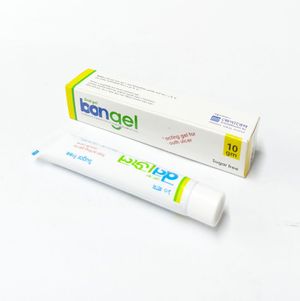Bongel Uses, Dosage, Side Effects and more
Choline salicylate alleviates pain by inhibition of prostaglandin synthesis and reduce fever by acting on the hypothalamus heat-regulating center. It also blocks the generation of impulses.

| Attribute | Details |
|---|---|
| Trade Name | Bongel |
| Generic | Cetalkonium Chloride + Choline Salicylate |
| Weight | 01% + 8.714% |
| Type | Oral Gel |
| Therapeutic Class | Non-steroidal Anti-inflammatory Drugs (NSAIDs), Preparations for Oral Ulceration & Inflammation |
| Manufacturer | General Pharmaceuticals Ltd |
| Available Country | Bangladesh |
| Last Updated: | January 7, 2025 at 1:49 am |
Uses
Cetalkonium Chloride & Choline Salicylate is used for Mouth ulcers, Cold sores, Denture sores, Gum swelling, Apthous ulcer
Bongel is also used to associated treatment for these conditions: Cold Sore, Cough, Fever, Headache, Infection, Nasal Congestion, Phlegm, Sore Throat, Minor aches, Minor pain, Ulceration of the mouth
How Bongel works
Choline salicylate relieves pain by inhibition of prostaglandin synthesis and reduces fever by acting on the hypothalamus heat-regulating center. It also inhibits the generation of impulses through the inhibition of cyclooxygenase enzyme (COX) , .
Cyclooxygenase is involved in the production of prostaglandins, in response to injury and after various other stimuli. The prostaglandins promote pain, swelling, and inflammation. The choline salicylate decreases inflammation and pain by reducing the production of these prostaglandins in the area of the mouth it is applied to .
Dosage
Adult: Wash hand, apply ½ inch of gel on to the sore area. This can be repeated after every 3 hour.
How Long Does It Take to Work?
How Long Does It Take to Work? see here Bongel
Side Effects
Hypersensitivity reactions, skin eruptions, Paroxysmal bronchospasm; mild chronic salicylate intoxication.
Toxicity
LD50, oral in mouse: 2690mg/kg . Ld50, subcutaneous in mouse: 1gm/kg .
Interferes with thyroid function test .
Gastrointestinal (GI) disorders, fatigue, hypersensitivity reactions, skin eruptions, hemolytic anemia, weakness, dyspnoea; local irritation (rectally); Reye's syndrome.
Potentially Fatal: Paroxysmal bronchospasm; hepatotoxicity; renal impairment/failure; thrombocytopenia, iron-deficiency anemia, occult bleeding, leukopenia; mild chronic salicylate intoxication .
Salicylate poisoning is normally associated with plasma concentrations >350 mg/L (2.5 mmol/L). Most adult deaths due to salicylate poisoning occur in patients whose serum concentrations of salicylate are over 700 mg/L (5.1 mmol/L). Single doses of less than 100 mg/kg are very unlikely to lead to serious poisoning. Patients should be provided with supportive therapy or treatment for salicylate poisoning as necessary. This may include treatment like activated charcoal, urinary alkalinization and, in severe cases, hemodialysis .
Precaution
Peptic ulcers, errosive gastritis; asthma, allergic disorders; renal and hepatic impairment; dehydrated patients; uncontrolled hypertension; elderly.
Interaction
Increased toxicity of warfarin. Antacids may reduce salicylate effects. Increased risk of GI bleeding when used with corticosteroids.
Volume of Distribution
0.15 L/kg (salicylate), and widely distributed throughout extracellular water and most tissues
Elimination Route
Onset: 1-2 hr after ingestion
In the oral form, choline salicylate is absorbed across the buccal mucosa. There is a need for caution not to exceed the stated dose and monitor for any signs of suggested salicylism, especially when this drug is used for infants .
In one study, it was found that this drug was more rapidly absorbed than ASA (absorption t1/2 = 0.1 vs 0.36 h) .
Half Life
The plasma half-life of salicylic acid is 2-4 hours . Up to 15 – 30 h with larger doses due to saturation of liver metabolism capacity .
Elimination Route
Both metabolites of choline salicylate, and a small amount of intact salicylic acid are excreted, primarily in the urine [L1239].
Pregnancy & Breastfeeding use
Pregnancy Category-Not Classified. FDA has not yet classified the drug into a specified pregnancy category.
Contraindication
Haemophilia, haemorrhagic disorders, gout, history of hypersensitivity to salicylates. Severe renal or hepatic impairment; childn <12 yrs. Pregnancy and lactation.
Storage Condition
Should be stored in cool and dry place.



